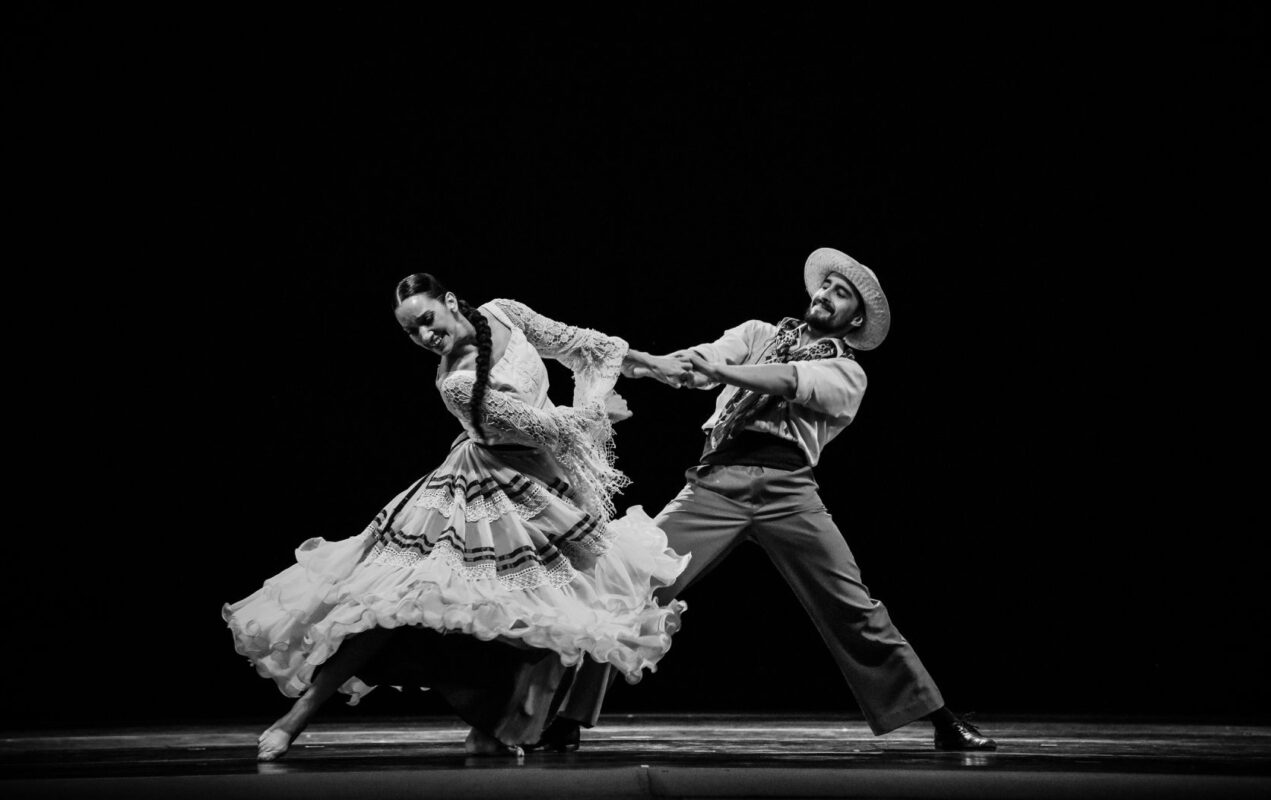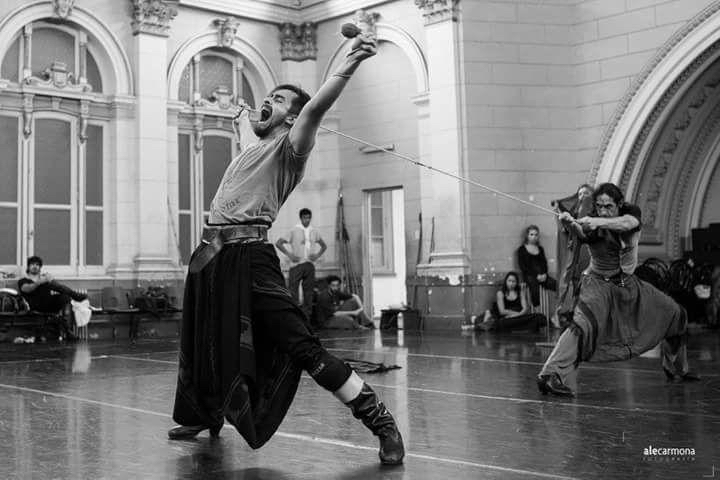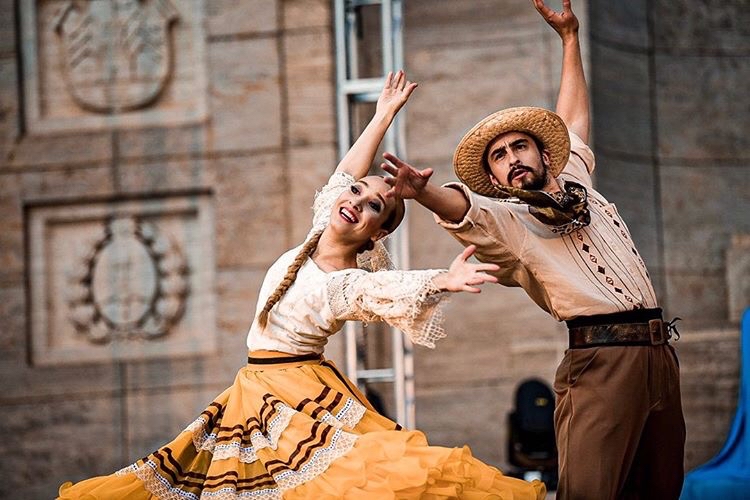
What dance has given me
I was born in Córdoba. At the age of three, I was sent to the Ameridanza studio, for which I am eternally grateful. Its founders, Liliana Muñoz and Pablo Ledesma, are like my second parents. There, I danced folklore and Latin American dances. Dance alternated with school. I always experienced it with joy. My sister was also there, a great dancer. I would return from school, eat, and at five in the afternoon, I would go to Ameri, where I stayed until ten every night. It’s a spectacular memory. My family was involved, participating in food fairs or organizing festivals, with my dad operating the grill and my mom making costumes.
Folk dancers participate in competitions and have extensive performances throughout the country. With Ameridanza, I was fortunate to go to contests once a month. Unlike classical dance, there is a significant stage experience where you finish your training and find places to perform. It’s not a once-a-year performance or a showcase. No, folk dancers have an extensive stage journey.
When I was a child, they would tell me, “You have to go up there and do what we taught you.” There were a thousand people in a stadium, and whether it was good or bad, I would tap dance. I danced, got off the stage, and it was time to form a soccer ball made of rags with the kids from different academies. In adolescence, there was more of a competitive aspect. But over time, when I met other dancers at a “peña” or during a conference, I began to understand that it’s about sharing and celebrating. The pressure came from within, depending on how you were taught about competition. When you realize that you share the same studio, for example, for the “jota cordobesa” or the “cueca neuquina,” and you see another dancer and say, “Look at how they dance.” That sense of community is very characteristic of folk dance..
As I grew older, I studied classical dance, jazz, and a bit of flamenco. However, I focused my studies on folk dance. At age 20, I entered the classical dance seminar at Nora Irinova’s studio at the Teatro Libertador, where I had experiences as a guest, an extra assistant, and a supporting dancer. I joined relatively late, but there was always a need for male dancers. A girl would perform as a male dancer when there was a shortage. She didn’t need to draw on a mustache or anything; she just needed to tap dance, and she did. That also happens at “peñas,” where you might find a circle of women dancing together and another circle of men dancing together. Fortunately, we are breaking free from traditional gender roles, and these changes are welcome, such as female “malambo” or combined “malambo.”
As a folk dancer, I was invited to Buenos Aires to perform in a concert with Soledad Pastorutti. There, I said, “I need to come here.” And so it happened; the following year, 2003, I was trying my luck in the big city. A friend had told me there was a vacancy in the national folk ballet, and I also had a proposal to join a tango group. My parents bid me farewell, thinking, “He’s coming back, unsure if he can handle it.” But a week after arriving in Buenos Aires, I auditioned at the Teatro Colón and got in, and the following week, I made it into the ballet. Thank God, within a week of arriving in Buenos Aires, I took the male dancer course at the Teatro Colón in the morning, and in the afternoon, I was rehearsing with the folk ballet.

I lived in Belgrano and took the subway at night. I would get off at the Tribunales station on Line D and see the Teatro Colón. I was happy to wake up early to go to class. At noon, I had free time, had a meal, and then went to the ballet. I was in heaven; I arrived in Buenos Aires at the age of 22, and I couldn’t ask for more. I started to measure myself healthily, knowing I had nothing to envy. That was very beneficial for me.
Even as a child, I would say, “I’m going to prepare for an audition.” Dance was always a way of life, from how I ate to how I trained. I can make a living from dance, which means a lot. I am happy doing what I love, which goes beyond how much I earn as a public employee. I’m talking about not complaining about getting up to dance or train at any hour. I’m talking about both the artistic and the administrative aspects. Additionally, dance has given me friends. I have friends in Corrientes, Misiones, Tucumán, Salta, Neuquén. Wherever I go, those connections are there.
Folklore is not just dance
I always wanted to enrich the dancer. I was concerned about taking more and more classes. We would leave the Colón Ballet and six or seven of us would go to Manuel Vallejos’ studio to dance jazz. There were fabulous characters. My great love, a teacher of life and dance who continues to shape me, is Mónica Fracchia, who has the Castadiva company. I arrived in 2003, and in December of that year, she had a performance at the Ombligo de la Luna. I saw it and said, ‘I want to dance that.’ The following year, I started taking her classes and joined her company, with which I am still connected. Our motto is ‘Nobody leaves Castadiva.’
I also took tango classes. Age plays a role; you start with nostalgia, and tango emerges, as well as the atmosphere of the milongas. In Córdoba, there are many folk dance gatherings, and there are many tango venues. Between contemporary, jazz, and tango, my days were fully occupied. Norma Viola and Nidia Viola were still alive when I joined the ballet. I had great respect for these eminent women in dance. I could absorb the knowledge of these legends, suckling from their wisdom the challenge of forming the ranks of the national folk ballet.
But folklore is not just about dance. You are creating a stage representation that includes customs, myths, and the worldview of a region.. In traditional dance competitions, they scrutinize every detail of the costume and hairstyle. That’s why there are small textile and gastronomy industries associated with folklore. If we talk about the Pachamama, there is dance and the ritual of asking the earth, including agriculture, livestock, and food. Folk dance is not just about choreographic skills. Each dance is related to a culture. ‘I want to learn to dance chacarera.’ Yes, but first, let’s see what the lyrics say and why they talk about Santiago in that way.. In the milongas, tango is social. Tango is the embrace, the scent, the hand, and how you get along with the person you’re dancing with. It’s sharing wine, enjoying the table, listening to the music. It’s what you try to convey to the newcomer: tango isn’t just making a figure-eight and lifting your leg. The music speaks of the streets of Buenos Aires, the cobblestones, and the tram. Tango is danced with all that, and all that is tango.”

The professionalization of the folkloric dance artist
I have always been an involved person. I was part of the student council for three years in high school. I was already taking charge of things, working in teams. When I arrived here, Norma Viola was among the first to raise the flag to secure costumes and a budget for the folkloric ballet. She asked for help and discussed the need for a stable organization for the dancers and was very forward, defending her dancers and technicians. She stood up to ministers and secretaries. I got involved even though I wasn’t a delegate. I helped with issues related to establishing a stable organization for the folkloric ballet or drafting some notes. That’s where I started to get involved.
A dancer has a manager and a teacher. You move where you are taken. I began to enjoy writing notes and forming teams – if there’s one thing I want, it’s working in teams. The folkloric ballet has a great tradition of holding organized and constructive meetings. These are years of meetings where you dialogue, construct, and learn a lot.. Also, a friend had completed a cultural management program, and I read his notes. Later, I pursued the same program, got more training, and realized I had been doing management-related things. Advocacy is critical. You can learn a lot if you can listen and be influenced by your peers. There’s a strong sense of unity, and you feel like you’re moving forward.
From my point of view – which relates to my experience as an independent dancer and a ballet member – contemporary dance is the discipline at the forefront of organization and management, establishing networks and connections. In their training, they know management must be there beyond the artistic part.. Most people who apply for grants, in the majority, come from contemporary dance. That makes you wonder if folklore doesn’t need subsidies. Of course, it does. But it lacks awareness; it doesn’t know how to seek them. In comparison, contemporary dance in Buenos Aires, compared to the rest of the country, is ahead in this regard.
In the Premios Chúcaro association, I admire young people who, at just twenty years old, are cultural managers and work in production. There was an independent company in the past, and the director handled the lights and management while doing the choreography. Now, there’s an associated producer who takes care of that. That is very positive, and we are encouraging it through the association. The artistic side is excellent, but let’s also pay attention to management. Cuando querés llevar una muestra a escena, cuando querés vender una entrada o cuando querés vivir de esto, viene esta otra parte. I want to see leadership and production included in dance curricula at universities like the UNA.

Premios Chúcaro is a non-profit civil association. It was formed through Ricky Pashkus’ idea. He had been working with folklore in Argentina Baila, a very nice program for public television. He was surrounded by beautiful people there, and the idea of forming an association that would promote the professionalization of folkloric dance artists – which, in the context of the pandemic, expanded to all dance – emerged. To take classes at Premios Chúcaro, you don’t have to come from folklore; someone from flamenco or contemporary dance can come. Before the pandemic, we awarded prizes in seven categories: best male dancer, best female dancer, best work, and musicalization. It was pretty national, with judges and delegates from all over the country and a notary public.
The association comprises a beautiful team, and young people with tremendous drive are joining. We continue to project ideas and be as national as possible. We have participants from Germany, Russia, and Colombia, thanks to virtuality. In 2021, we started Germinart, a program for folkloric scenic projects. Five projects will be selected, and they will receive mentoring.
One of the girls in the association also works at the Ministry of Women. Regarding gender issues, she proposed organizing a women’s festival. We decided to create a department dedicated to that. We know that in the UNA, in folklore, there are women who are constantly concerned with diversity and gender issues, just as there is a queer folk dance peña in Avellaneda. We are thinking about these issues, as well as accessibility. I took a public cultural management course from the Ministry of Culture and realized that we are far from making everything accessible to everyone, especially people with disabilities. These are aspects we are paying attention to.
Being a manager means knowing how to communicate, listening, and having a service-oriented attitude. At 41 years old, I may be too old for some things. That’s why it’s good to surround yourself with young people because they experience something I haven’t. But it’s also good to have older people. Although we are few, the association is a broad and national movement with a representative from every province. In our forms, we always ask, “What do you think we are missing?” and “What contribution do you think you can make to the association?” We always say that the association is not just ours; enjoy it your own..
Let dance not lose its sense of community
In the context of the pandemic, there were no performances of works. So, at Premios Chúcaro, we shifted our focus to training. In 2020, we offered individual classes by inviting teachers. The first class was a huge success, with seven hundred participants, and throughout the year, we had more than five thousand registrants. We made significant progress in the audiovisual realm. Since we were planning to launch an award for folkloric video dance, we believed we needed to provide training first. We organized a comprehensive workshop comprising thirty hours with four instructors, which was entirely accessible for those who enrolled. We are securing funds through financing, sponsorship, and contributions from the association.
In this challenging context, virtuality is likely to remain in many places. However, we must ensure it happens as little as possible. Speaking through a screen is not the same as being in a bar, and watching a concert via streaming is not the same as attending a live performance by a band. The same applies to dance. We shouldn’t accept the idea of, ‘I won’t bring you to San Juan; just give me a Zoom class.’ Let’s return to in-person interactions. We are dealing with bodies. Contact is essential, and we need to see if teaching is effective. We shouldn’t give in to requests like ‘create the choreography for me over Zoom.’. Let’s use the right tools, such as this new narrative that emerged with video dance, but let’s keep in touch.
The context is devastating for the sector. Many colleagues are taking on jobs like delivering food by bicycle. They roll up their sleeves, and it’s admirable because they continue to engage with dance, creating choreography showing a step. That’s when I realized how fortunate I am to be a federal employee. It’s a position I want to value and defend every day. I like dance to improve and maintain its sense of community and association. I am going to a theater, witnessing something performative in the street, public spaces, or anywhere, and being there to see it. And if it’s classes, being in physical contact.